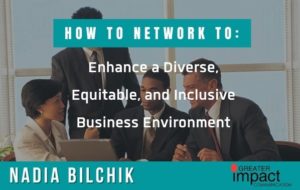 In my previous blog, Networking to Enhance a Diverse, Equitable, and Inclusive Business Environment, we spoke about how it has become widely accepted that companies committed to Diversity, Equity, and Inclusion benefit from a “diversity dividend” for a whole range of reasons, including gaining access to diverse markets and tap into different and often innovative perspectives.
In my previous blog, Networking to Enhance a Diverse, Equitable, and Inclusive Business Environment, we spoke about how it has become widely accepted that companies committed to Diversity, Equity, and Inclusion benefit from a “diversity dividend” for a whole range of reasons, including gaining access to diverse markets and tap into different and often innovative perspectives.
HOW do we enhance a diverse, equitable, and inclusive business environment effectively?
The first and probably most uncomfortable step is to check for bias in yourself and others and ask yourself if you rely on obsolete information and stereotypes.
The next step is to feel comfortable with that discomfort and understand that this is a natural reaction. We all feel more relaxed in a familiar environment when connecting with individuals where we share the same history and culture. I’m sure you have often had that experience in a networking event of being introduced to someone and had an instant reaction to that person based on previously collected data of who that individual reminded us of. Now you face the challenge of using those interpersonal skills to connect with people whose life stories and culture may not be as familiar.
It Can Be Challenging
It can be challenging to reach out and connect with diverse individuals, but you can employ strategies. Paula Caliguiri, a professor at Northeastern University in Boston specializing in international management, points out that confronting the new and unknown activates our limbic system, the deep part of our brain that triggers an automatic response to a conscious or unconscious threat. The way to deal with it is to be honest and recognize the reaction, but then take steps to slow down that response. It is the same as contending with a state of nerves before launching into any event where you need to get to know and connect with many strangers. Essentially, there is no blame in acknowledging your discomfort if you can then override the response and look beyond it. The ability to do so begins with a deep self-awareness and constantly checking in with your innate feelings.
Humans under situations of stress cling to the familiar. “It’s the way our brains work,” says Caliguiri. “Any time we’re under pressure, we move to cognitive ease. Think about what it is like to be a college freshman. There you are, starting college for the first time and walking into an orientation where they don’t know anyone. So naturally, you’re going to be nervous and cling to anyone who looks familiar. And often, it’s based on demographics because they don’t have any other cues to go by.
“Keep in mind that our internal processors are always talking to us,” she says. “It’s a kind of a continuous stream of noise that’s making sense of the world and giving us cues about what’s going on in the world or the environment.” What we need to do, she suggests, is use the prefrontal cortex – the rational, conscious part of our brains — to say to ourselves that we can’t rely on our gut right now. Instead, we need to employ the conscious and rational parts of our brains and personalities already practiced in making meaningful connections.
Take the Challenge
Question that gut response or feeling. Instead, remind yourself that while that person may represent a specific type to you, they are, in fact, a unique individual, and seeing them as such will increase your chances of developing a meaningful connection. And then you can even go beyond Issues of Diversity and Inclusion to developing what Caliguiri calls “cultural agility.”
Caligiuri describes “cultural agility” as the ability to comfortably and effectively work in different countries and work with people in different cultures. “Whether you’re getting on a plane and going somewhere, or you’re just working on a multicultural team via Zoom. It’s that idea that we’re working in a multicultural environment, and we’re good at it.”
Step 2- Show Genuine Interest
The second step in expanding your network to be more diverse and inclusive is to use the skills of an expert networker to show a genuine interest in the other person. This, as author Scott Peck says, requires “putting yourself aside in the conversation.” It is the ability to ask questions with respectful curiosity. And it is also making sure to avoid interpersonal blunders that might be offensive to other cultures. From there, you can proceed to the next step and try to find out how you are similar. “The easiest way to melt differences,” says Caliguiri, is “really finding that toehold on how two people can connect and what we share in common.”
So, what could that be? Food is a prominent topic, as long as you don’t express distaste for the kinds of food that someone from another culture might enjoy. Another neutral topic dear to all of our hearts is the weather. It may be trite, but everyone experiences weather similarly, and it’s a reason why it’s a comfortable topic. Sports is another topic, as long as you avoid potential controversies or uninformed judgments about players or sports culture.
Step 3- Build Trust
The next step is to actively join the effort of building a work environment of trust, respect, and psychological safety that enables people to speak up without fear of criticism or penalty. Then, you can be the individual who is alert for hurtful or disrespectful comments—either your own or those of others. In effect, you can choose to be an upstander as opposed to being a bystander.
There is no reason why you can’t constructively address these issues to create a more inclusive environment. However, it is also helpful to be aware of your intent and impact. For example, if you said something that caused an unintended effect, explore what you could have done differently.
Respect is equally critical. It is the ability to honor differences. In Diversity, we talk about traditional aspects of Diversity such as ethnicity, religion, race, gender, and additional elements like military experience, marital status, and personality style. Deep respect comes from acknowledging and honoring differences without judgment.
Additional Tips
Empathy is another vital competency. It is taking time to see the world from the other person’s perspective and honoring what obstacles the individual may or may not have had to overcome and the importance of their achievements. It is one of the cornerstones of emotional intelligence and requires sensitivity.
One helpful notion of keeping in mind is to realize the extent to which we are socialized and embedded in a particular culture. It’s not just that we’re all socialized identically because we live in a certain country. Instead, we’ve been associated with our family, education, religion, profession, a sport we play, and political views.
Think Outside of Your Cultural Box
Change is hard, especially if you feel the culture and attitudes you grew up with and are most comfortable with are hardwired into your DNA. However, it gets easier if you think about every bit of cultural agility as having a recipe. For example, while personality traits like tolerance of ambiguity, resilience, humility, and perspective probably have an inheritable component, there’s a portion of every competency that’s behavioral that you can learn and change.
The bottom line is human beings will always do what is easy and familiar. Our brains are wired to see the “other” as a danger. That is why it is essential to recognize whatever form the “other” comes in, be it age, personality style, ethnicity, or culture. It is possible to step back from the part of you that instinctively draws away and instead appreciate the unique contributions everyone can bring to your network.



